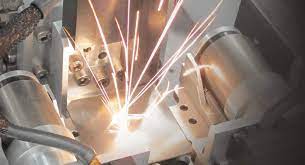Introduction In the realm of modern manufacturing and fabrication, laser welding stands out as a sophisticated and highly precise technique. This article delves into the essence of laser welding, exploring its process, tools, and various machine types, much like the detailed exploration of CNC drilling.
What is Laser Welding? Laser welding is a process that uses a laser beam as a concentrated heat source to join multiple pieces of metal or thermoplastics. This advanced technique is known for its high welding rates and deep penetration. The laser beam provides a concentrated energy source, allowing for narrow, deep welds and high welding rates.
Advantages of Laser Welding Technique Laser welding offers several advantages over traditional welding methods:
- High Precision and Accuracy: The laser beam can be focused to a pinpoint, allowing for extreme precision in welding, which is essential in industries requiring high-quality welds.
- Minimal Heat Input: Laser welding minimizes the heat input into the material, reducing the heat-affected zone and preventing material distortion.
- Versatility: It can weld a variety of materials, including different types of metals and thermoplastics.
- Automation and Speed: The process can be automated and is faster than traditional welding methods, which increases productivity.
How Does Laser Welding Work? Step-by-Step Procedure Understanding laser welding requires breaking down its process:
- Design and Planning: Like CNC drilling, the process begins with detailed planning, often using CAD software, to define the weld path, power, and speed of the laser beam.
- Choosing the Right Laser: Selecting the appropriate laser (CO2, Nd: YAG, or fiber laser) based on material, thickness, and welding type.
- Material Preparation: Preparing the materials to be welded, ensuring they are clean and properly aligned.
- Setting Up the Laser Welding Machine: Configuring the laser parameters such as power, pulse frequency, and beam diameter.
- Welding Process: Executing the weld using the laser, which follows the predefined path to join the materials.
- Quality Check and Finishing: Inspecting the weld for quality and performing any necessary post-weld treatments like polishing or heat treatment.
Key Components of A Laser Welding Machine Similar to CNC drilling machines, laser welders consist of several crucial components:
- Laser Source: The heart of the machine, generating the laser beam used for welding.
- Beam Delivery System: Guides the laser beam to the workpiece, often using mirrors or fiber optics.
- Worktable: Where the pieces to be welded are placed and secured.
- Control System: The interface for programming the welding parameters and monitoring the welding process.
- Cooling System: Maintains the temperature of the laser source and optics.
Types of Laser Welding Machines Various laser welding machines are available, catering to different applications:
- Pulsed Laser Welders: Ideal for spot welding and joining thin materials.
- Continuous Wave Laser Welders: Suitable for deep welds in thicker materials.
- Fiber Laser Welders: Known for their efficiency and precision in welding complex components.
Applications of Laser Welding Laser welding is versatile, finding applications in several industries:
- Automotive: For welding parts like gear components and battery packs.
- Aerospace: In the fabrication of lightweight structures and components.
- Medical Devices: For assembling small, precise instruments.
- Electronics: In joining small parts in electronic devices.
FAQs
- Is laser welding suitable for all metals? Most metals can be laser welded, but the process parameters vary based on the metal type.
- How thick can materials be for laser welding? It depends on the laser’s power, but typically up to a few millimeters for most lasers.
- Is laser welding expensive? The initial investment is higher, but the efficiency and speed can offset the cost in high-volume production.
Conclusion Laser welding represents a precise, efficient, and versatile method of joining materials in modern manufacturing. Whether for intricate components in the medical field or robust parts in automotive construction, laser welding offers a solution that combines the best of technology with unparalleled quality.
Interested in Laser Welding Services? For those seeking expert laser welding services, we provide top-tier solutions tailored to your unique requirements. Contact us today to start your laser welding project with the assurance of quality and precision.
Other Articles You Might Enjoy
- Innovative Solutions in CNC Machined Medical Implants
CNC Machined Medical Implants: An Introduction Medical implants are devices or tissues placed inside or on the surface of the body to replace missing biological structures or enhance existing ones.…
- Affordable CNC Machining Manufacturer for Titanium Prototyping
Introduction to CNC Manufacturing CNC, standing for Computer Numerical Control, is a manufacturing process where pre-programmed software dictates the movement of machinery. This technology has revolutionized the manufacturing industry by…
- Mastering CNC Machining: Understanding Rivets and Tack Welding( cast iron steel Yvonne)
CNC machining technology, an automated process for production where computers run pre-programmed sequences to control machinery, has become revolutionary in manufacturing industries. Two essential aspects of this operation are rivets…









